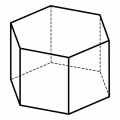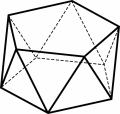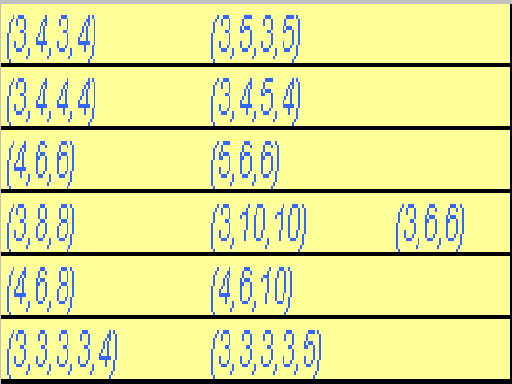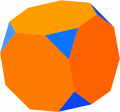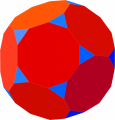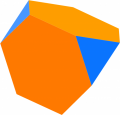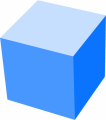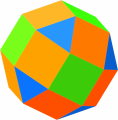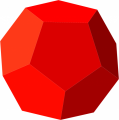The torus knots are knots that can be drawn on the surface of a doughnut. The mathematical name of a doughnut is torus, and that is why they are called torus knots.
These knots are completely determined by a pair of integers, and it is not too difficult to understand how this works. One can form a torus by gluing together the edges of a cylinder, so let us try to generate the torus knots from a cylinder. Fix on the surface of a cylinder some number (three in the picture) of line segments parallel to the axis of the cylinder and uniformly spaced around the surface of the cylinder. In the example of three segments, each can be obtained from the other through a 120 degrees rotation, since 120=360/3.
Now, imagine that the cylinder is flexible and let us close it up so to give it the shape of a doughnut or torus.

In doing so, we have three points on each circle—the ends of the line segments—that have to be identified. If we glue the two circles without any twists, then each endpoint of one of the line segments on one circle is identified with the point on the second circle belonging to the same segment. The result is three circles that are not linked, which is not very interesting.
However, if we twist the cylinder before gluing together the edges, we have a number of interesting possibilities. Of course, we cannot twist arbitrarily. We must twist in such a way that each of the three endpoints of the segments on one circle is glued to one of the three endpoints on the second circle. The twist must therefore correspond to an angle that is a multiple of 120 degrees. This process explains why torus knots are characterized by two numbers: the (p,q) torus knot is obtained from p equally spaced segments on a cylinder whose endpoints are identified after the cylinder is twisted through an angle of q x (360/p)degrees.
The result of this process can be a knot with more than one component. Such cases can be easily read off from the two numbers. Indeed, the number of components is equal to g.c.d(p, q), that is, the greatest common divisor of p and q. In particular, we get a knot with a single component when p and q are coprime.
For instance, let p = 2. That is, let us begin with two line segments on a cylinder. We will obtain a one-component knot when q is odd, and a knot with two components when q is even.
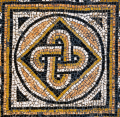
The (2,1) torus knot is the unknot. The (2,2) knot is made up of two linked circles. The (2,3) knot is the trefoil. The (2,4) knot is the Salomon knot, of which there are countless examples in art (since the time of stone engraving).The (2,5) knot is often used in artworks. One of the "imitators" of the Borromean rings is also a torus knot, namely the (3,3) knot. 
The two integers that characterize a torus knot can be interpreted as representing the number of times that the curve (or curves) "winds around the hole". The number p gives a measure of how many times the curve winds longitudinally; that is, to obtain p, one can count the number of points in which the curve intersects a meridian. The number q gives a measure of how many times the curve winds in the other way; that is, to obtain q, one can count the number of points in which the curve intersects a parallel.
Torus knots are a family of knots which are "handy" to be investigated because they are completely determined by two integers. They are an example on which it is quite natural to test general statements on knots. This family is quite rich so that the examples are not trivial; at the same time, it is fairly convenient to be studied with respect to the intricacies of a generic knot







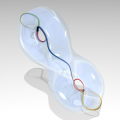
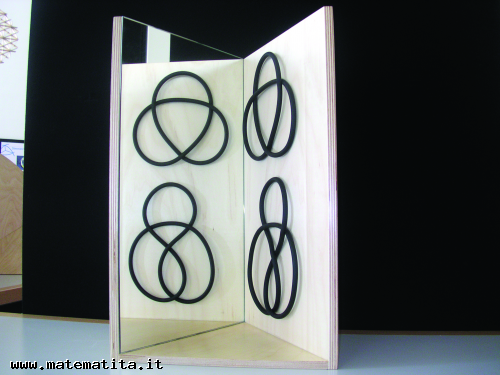
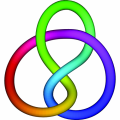
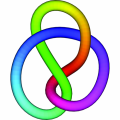

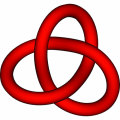
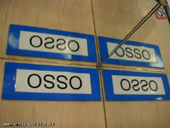 The virtual leaflets you find in this section are those of the exhibition "Symmetry, playing with mirrors".
The virtual leaflets you find in this section are those of the exhibition "Symmetry, playing with mirrors". 